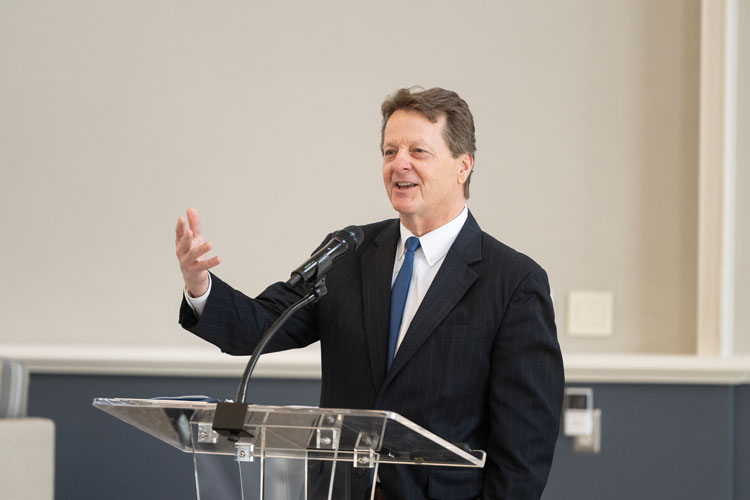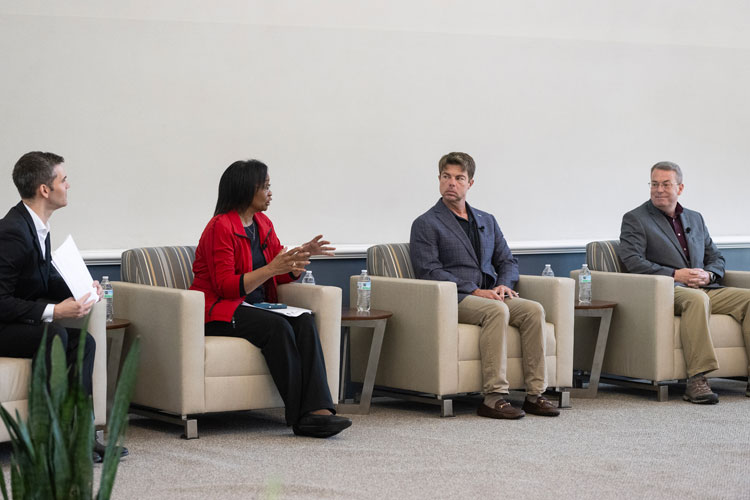
Mississippi UAS Symposium panels discuss legal, commercial, public use of drones
From war zones to grocery deliveries, autonomous and piloted drones are invading the public sphere, but legal concerns for uncrewed aircraft are still hovering overhead, industry experts said Tuesday, April 30, 2024, at the inaugural Mississippi Uncrewed Aircraft Systems Symposium.
Industry and legal experts from across the country gathered at the University of Mississippi to discuss the legal, commercial and public opportunities in the world of drones. The symposium was hosted by the School of Law in collaboration with the Mississippi State University Raspet Flight Research Laboratory and the Mississippi Enterprise for Technology.
“We chose the theme ‘What can that drone do for you?’ because we wanted to challenge people to think not just about how we use drones today, but also about all the possibilities and opportunities the platform offers,” said Michelle Hanlon, executive director of the Center for Air and Space Law and a moderator for the symposium.
“And what I think we learned today is that drones can certainly do a lot, but there are still some challenges to overcome.”
The drone industry in the United States has grown exponentially since 2016, when the Federal Aviation Administration eased regulations regarding drone piloting, and required potential drone pilots to acquire a pilot’s license. Alongside their commercial uses, drones are used for geological surveys, inspections of infrastructure and in assessing storm and natural disaster damage around the world.
“We’re even using UAS in search and rescue,” said Griffin Sekul, uncrewed aircraft system coordinator for the Mississippi Emergency Management Agency. “We’re able to get into places we wouldn’t be able to get to and see the things that we wouldn’t be able to otherwise.”
Between 2016 and 2022, nearly 1 million Americans acquired pilot’s licenses, 300,000 of which were remote pilot licenses, according to the FAA. The drone industry is valued at more than $19 billion worldwide and more than $4.5 billion in the U.S., with both those numbers expected to more than double by 2030.
“Back in 2016, the FAA required a registration process of drones,” said Sharon Rossmark, CEO and founder of Women and Drones. “To date, we are approaching 1 million drones in the national airspace. Why is that important? Because drones are flying in the same airspace as airplanes, helicopters and even hot air balloons.
“What that means is we’re seeing a record number of aircraft in the air.”
Despite this growth, the legalities surrounding drones are still evolving, said Grant Guillot, vice president of regulatory affairs for DroneUP, a drone delivery company.
One of the biggest barriers to drone delivery is the FAA’s rule restricting drone flight beyond the pilot’s visual line of sight, Guillot said.
“This has been the biggest thorn in the side of the drone industry, and it’s one we’re hoping to alleviate with this new FAA reauthorization,” he said, referencing the legislation before Congress that would fund the FAA and set new regulations for drone pilots.
“That’s why you don’t see many drones flying packages around right now. We’re looking to change that. This is what we see in other countries, and that’s why you see so many drone deliveries in Australia, Africa, Europe.
“Every single continent is more advanced in providing BVLOS (beyond visual line of sight) flights.”
Passing such legislation, however, is complicated, said Craig Morris, instructional associate professor in the Center for Intelligence and Security Studies at Ole Miss. Morris, a 29-year veteran of the U.S. Air Force, worked extensively with uncrewed aircraft during his time in the military.
As drones have grown more accessible, so has their capacity for destruction.
“You can see now, going to YouTube, drones that cost maybe $150 strapped with weapons being used in the battlefield,” Morris said. “This spells the problem of the future. What about this tech is going to change and become more relevant and more available in the future?
“What’s to stop someone with nefarious purposes doing something bad with these drones in the U.S. airspace? Do we have the infrastructure and policy in place to stop that?”
The laws and regulations surrounding unmanned aircraft must balance the utility of drones with the potential threat they pose both to safety and privacy, said Phillip Weissman, aviation authority for Advanced Air Mobility Professionals.
“While drones offer some amazing societal benefits, they also present some unique regulatory challenges,” he said. “Will there be people who demand that drones get off their lawn?
“It’s already happening. There have already been reports of people shooting down drones.
While regulations catch up with drone technology, the use of unmanned aircraft will continue to spread across industries, Guillot said.
“Anything we can do to introduce young girls and boys to this technology, anything we can do to broaden the workforce will be beneficial, because these things are coming at an astronomical rate,” he said. “We’re missing half of the workforce we need.”
Training that workforce is a goal of the Center for Air and Space Law, said Fred Slabach, dean of the Ole Miss law school.
“Our Center for Air and Space Law is tackling legal policy and regulatory aspects to help support the healthy growth of the drone industry, and we’re leading research efforts to take advantage of the many opportunities drones present,” he said.
“This isn’t just an afterthought for the University of Mississippi law school. The law school has been the leader for air and space law education since 1965.”
By Clara Turnage







